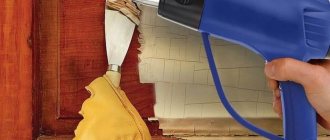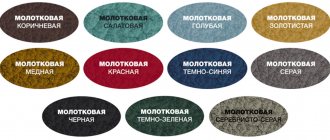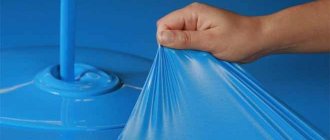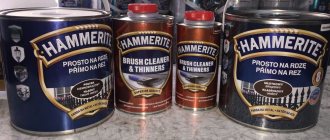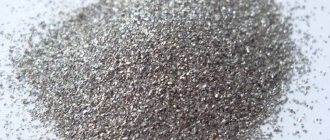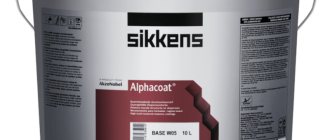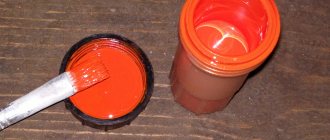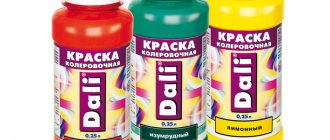Advantages of acrylic-based dyes
Acrylic paints are water-based paints. They contain coloring pigments, polyacrylates and water. In such a water-based paint system, the molecules of the polymer substance are collected into round particles that form a dispersion mixture with water.
Until recently, acrylic paints were used to decorate concrete, brick or wood surfaces, but recently they have been increasingly used for metal work. A significant role in this choice was played by the fact that after drying, acrylic water-based paints form a coating that does not crack due to seasonal and daily temperature changes , and their decorative qualities are preserved for several years.
Manufacturers of construction and finishing materials of this group, taking into account the ability of the surface of metal products to corrode, included special substances in the composition of acrylic dyes that interact with rust products in order to prevent peeling of the decorative layer.
A significant advantage of acrylic dyes is the ability to easily wash with water immediately after finishing all the tools that were used in the process of applying them.
The main negative property of most metal surfaces, unless, of course, we are talking about aluminum or silver, is their ability to enter into chemical interaction with atmospheric moisture, as a result of which the top layer of the metal product becomes covered with a crust of oxides, that is, it is subject to corrosion.
The anti-corrosion substance contained in water-dispersion acrylic paints enters into a chemical reaction with oxidation elements, neutralizes their effect and forms a compound with inert properties on the surface being painted.
In addition to excellent adhesion to the surface being treated, called adhesion, and the presence of anti-corrosion components in such products, the film that forms after coating metal surfaces with paint and evaporation of water is highly elastic. It is able to withstand temperature changes and changes in deformation in a metal product , expressed in its stretching and compression. This is a very significant indicator, because all metals have a high coefficient of linear expansion, which is the result of temperature changes.
Another very significant advantage of acrylic water-based dyes is the absence of toxic substances and fire hazardous compounds. The water base makes them odorless dyes, so they can be safely used for interior work. For the same reason, they can cover metal surfaces without the need to use personal protective equipment, which is necessary, say, when working with nitro paints.
Acrylic dyes can be used, without worrying about safety, for exterior finishing work on oil and gas storage facilities, gas stations, and fuel and lubricants containers.
To dilute these products, it is not necessary to use a solvent for acrylic paints; ordinary water is quite suitable. Therefore, even the action of direct solar radiation does not lead to fading of such dyes, since they do not contain components that contribute to this.
Details
Advantages
Acrylic paints and varnishes began to be used relatively recently, but in record time they were able to gain popularity due to their unique properties. The mixtures are quite durable, and acrylic paints for metal processing remain on the surface without corrosion for 8 years. For many years, the coating will retain its protective qualities without requiring updates. Ultraviolet solar radiation and oxygen, reaching the top layer of simple paints and varnishes, also cause it to harden. As a result, it becomes more fragile, thinner and begins to crack. This does not happen with acrylic paints.
Painting metal with acrylic paint is the best solution. The white coating will not turn yellow and will not lose its gloss. This became possible due to the polymer emulsion, which plays the role of a binder, will not react to oxygen, and is not yet susceptible to oxidation. Despite the fact that the high-strength film on the treated surface takes quite a long time to form, the mixture dries quickly and after that it will not be affected by bad weather. For many coatings, metal corrosion has become a problem. The fact is that it begins to react quite quickly to condensation and moisture. As a result, a red, loose coating forms on it, which is called rust. Acrylic paints for metal (created for outdoor use) contain anti-corrosion substances. It begins to react with rust, and then forms an inert composition.
The film, which appears after 100% drying, has high elasticity. As a result, a metal surface painted with acrylic enamel is able to withstand all temperature changes. In this case, compression and stretching of the metal begins to occur, which due to the elasticity of the film, the paint does not fully affect it. In addition to all the advantages described above, acrylic paint for metal does not contain toxic or fire hazardous substances. For this reason, the coating is ideal for painting oil and gas storage facilities, as well as gas stations. Paints for metal processing (for outdoor work) can withstand temperatures up to +125 degrees. Special compositions are made from silicone resin, and epoxy-bitumen types of coatings are also used. Silicone resin compositions can withstand temperatures up to +600 degrees, and bitumen ones only up to +400 degrees.
Flaws
Acrylic coatings have certain disadvantages, but they can be dealt with fairly easily. Initially, the mixture dries out very quickly, but the complete formation of a layer of acrylic paints for treating metal surfaces and obtaining a stable film will occur within 1 month. During this period, the enamel dries out completely and “tightly” hardens. For 1 month after application, while the paint layer is pliable, it should be protected from all types of deformation and contamination. Another point that can be attributed to the minus is the decorative qualities, and most paints have a richer and brighter range of colors. Acrylic products have more muted tones, but for painting fences and roofs this is not so important, and therefore this can only be considered a disadvantage of color properties. The price of acrylic coatings is much more expensive than the most common paints and varnishes. But this can only be conditionally classified as a disadvantage, because the mixtures are durable. But acrylic compositions do not tolerate severe frost so well.
Application method
Before starting the painting process, it is worth preparing the surface to be treated. If there is rust on the product, it should definitely be removed. This can be easily done with a wire brush. You can also use a rust converter to remove corrosion. Before painting, metal surfaces must be cleaned of dirt, grease, dried and primed. In this case, the composition will lie evenly, and its consumption will be greatly reduced. The preparatory stage of the treated surface is a very important factor that will increase the durability of the coating. Before fully painting the fence, parts and roof or other metal products, you should first treat the individual “recessed” or protruding fragments with enamel. This can be done with a small can of paint or a brush.
Water-based acrylic metal paint should be mixed before use. It can be applied with any convenient tools. But they all have certain features. For example, a brush can leave streaks, and a roller can create shagreen, although in the second case the coloring will be of better quality. It will be quite economical and effective to spray the paint composition through a spray bottle. This may require a thinner consistency, but dilution with water is carried out strictly according to the instructions. All necessary proportions must be observed.
Ideally, a layer of paint and varnish material should be applied 2 times. If the layer turns out to be thicker, then this violates the film elasticity. The interval between two applications of the composition should be 1-2 hours. Since this paint does not have rich, bright colors, they can be obtained by adding specialized pigments. It is difficult to achieve such a color, and therefore it is better to make the required amount of paint with a reserve. The best option would be computer tinting, and in this case it will be quite easy to repeat the desired color.
If you plan to use acrylic paint on metal for interior work, and the color should have a beautiful glossy color, then you can replace it with acrylic varnish with polishing. If you wish, you can initially opt for a matte finish. Since the material is resistant to high temperatures, the coating can be used to apply paint to heating radiators. A competent choice of composition for processing metal products makes it possible to get rid of corrosion for many years. The minimum effective life of acrylic paint and varnish compositions is 7 years, but such coatings can last much longer if the product has been previously cleaned of rust. Acrylic paints on metal for interior work can be used not only for fences and roofs, but acrylic paints are also actively used for facade work and interior metal finishing work.
Why determine whether the paints on the surface are compatible with the paint used?
Paint and varnish materials often have to be applied to a surface that is already covered with some kind of paint and varnish material. These can be primers, putties, various enamels. They may differ in the pigments included in the composition and in the film-forming base. In order for the surface to be painted successfully, and for it to acquire an attractive appearance, it is necessary to ensure that the materials are compatible with each other.
If you attempt to coat over a material that is not compatible, the resulting surface will be of poor quality. Its appearance will be spoiled, and it is possible that soon after drying the paint will begin to crack and fall off. The composition will need to be removed soon and the painting work will need to be done again. This is not only time-consuming, but also very costly financially.
Recommendations
Tips for painting metal surfaces:
- Some formulations cannot be used for drinking water containers.
- To paint stoves, you need to use enamels that can withstand heating above 500 °C.
- To prepare the surface of non-ferrous metals, you need to use special primers.
- Batteries and coils should be painted only after they have been turned off and cooled down.
Standard storage conditions for coloring compounds are 15–25 °C.
You can find different paints for metal surfaces on sale. They have certain features, strengths and weaknesses that need to be taken into account when working with them.
Is it possible to paint with acrylic paints on fabric?
Any acrylic will adhere to fabric or leather, but we recommend using special
fabric paints
: they create a flexible coating that will not begin to crack when the material is bent) and contain a heat-setting resin, thanks to which the paint layer will acquire special strength after exposure to temperature (ironing or drying with a hairdryer).
Acrylic paints are distinguished by their bright colors, flexible paint coating and high resistance to aggressive conditions. In this regard, if you correctly apply the design to the fabric, you don’t have to worry about it. Acrylic will not peel off, wrinkle or crumble. This paint easily tolerates temperature changes, mechanical stress and is not susceptible to moisture.
Compound. Advantages, possible disadvantages
The properties of water-dispersion acrylic paint for metal are determined by its composition, which is based on the use of polymers (acrylic resins), water and pigment.
Among the positive characteristics the following indicators can be noted:
- environmental Safety;
- quick drying;
- affordable price;
- the ability to obtain the required shade by adding the appropriate color;
- resistance to adverse external influences.
The need to paint metal surfaces arises both indoors and behind the walls of buildings. It is noted that when using acrylic varieties it is possible to obtain a reliable and durable coating.
apply without prior priming
The main reason for the destruction of metal objects is corrosion, which increases in the presence of water. The acrylic paint, oriented for metal work, contains an anti-corrosion substance that protects against the formation of rust.
Metal paint has another important characteristic, which is the ability to form an elastic film after drying. It does not crack during deformation changes characteristic of any type of metal products under the influence of temperature fluctuations.
Acrylic paint on metal for exterior use is in great demand because it does not fade, does not allow moisture to pass through, is nonflammable and resistant to mechanical stress.
Easy to apply water-based acrylic paint does not require specific skills or tools. You can use brushes to work with metals when processing surfaces with a small area. If you are painting a metal wall, roof or other fairly large surface, then it is advisable to use a roller or spray gun. The last option is the most economical, since when the acrylic composition is sprayed, the layer is uniform and very thin.
For rooms where water is often used, which increases air humidity, special types of metal paint are produced that create an ultra-resistant film.
It is necessary to take into account some of the disadvantages inherent in acrylic paint. Although the water-based ink mixture dries quickly, it may take up to 30 days for the film to reach full performance. During this time period, it should be protected from contamination and any shock and mechanical influences.
In some situations, the lack of richness of the color scheme can also be considered a disadvantage. This criterion can be important when decorating some individual metal elements, for example, in landscape design.
Is it possible to paint with acrylic paint on enamel?
It is advisable to apply a coating of acrylic paint to enamel under certain conditions. Some types of dyes are incompatible, so a neutral intermediate layer is required. To prevent acrylic paint from “curling” the enamel, apply a layer between them that will be resistant to both acrylic and organic solvents. Cover the enamel with liquid putty and then with acrylic primer.
How to determine what material a wall is covered with
To determine the type of coating, various methods can be used:
- The easiest way to determine whitewash. To do this, run your palm along the wall - if a white mark remains on the skin, it has touched the chalk solution.
- Acrylic or water-based paint can be determined by moistening the wall. If it does not change shade, the coating is made of a water-based mixture. Darkening indicates lime whitening.
- Latex paints. To determine them, they also use water, washing the wall with a rag. If an area of the surface washes out without problems, it is chalk mortar or acrylic-based paint. If there are no signs of dissolution, latex paint is used for the surface.
- Enamel stains can be identified by carefully inspecting the wall. Its surface in this case is shiny, with a slight gloss.
- It is not easy to distinguish oil paint from enamel paint, but the same mixtures can be used for it.
When treating walls and other surfaces before painting, it is recommended to use materials with the same type of binder. This is especially important for mixtures that are characterized by chemical curing (polyurethane, epoxy). To ensure adhesion of the layers, during the application of each layer it is necessary to carefully follow the recommendations for drying them.
Advantages
When compared with other types of coloring agents, acrylic is in great demand for its excellent qualities:
- resistant to sunlight;
- does not react to moisture, steam;
- have no pungent odor and are characterized by low toxicity. Therefore, it does not cause irritation to the upper respiratory tract. It is allowed not to use personal protective equipment (as when painting with nitro paint);
- does not require the use of special tools when painting. You can use brushes, rollers, spray guns and other handy tools. It is most economical to apply to the surface using a spray gun, especially when you need to paint a large area;
- after the work is done, the tools used can be easily washed with tap water;
- Sun rays, air and moisture have a negative effect on conventional paints, causing the top layer to harden, thin and crack. Acrylic does not have a similar effect;
- does not succumb to yellowing and does not lose its gloss;
- non-toxic and does not cause fire (rooms with gas and oil products at gas stations can be painted);
- after drying, the film becomes elastic. Elasticity protects acrylic from damage caused by sudden temperature changes.
Description of acrylic decorative paints
Most often, water-based acrylic compounds are used to decorate metal products, as they are easy to apply and safe. They can be used even by people prone to allergic reactions. It is also worth noting that these materials do not have a pungent odor characteristic of coloring compositions.
Important! No matter how hypoallergenic and safe water-based acrylic paints are, they should not be used to decorate items that have direct contact with food.
Any decoration of metal products requires special skills in working with coloring compounds. For example, you should know that when painting objects with acrylic paints, all devices should be washed only with warm water, immediately after finishing the work. Nowadays acrylic paints for decoration are available in a wide variety of shades, but gold and silver colors are best suited for applying decor on metal. Such solutions can be purchased in 100 ml tubes, in the form of sprayers or in standard jars of 50, 100, 150 and 200 ml.
If you are going to decorate metal products for the first time, then give preference to small sets of paints for decorating metal (often these types of products contain detailed instructions for mixing paints, as well as the required number of shades). It would be a good idea to purchase an additional tube of white paint, since this color is used up the fastest during the painting process.
How to apply acrylic paint to metal
When repairing or building, you will always need materials and paint.
Paint can vary in composition and purpose. If you need to process and paint metal, acrylic paint for metal is suitable. This type of material is very popular among the population due to its positive features.
- protects metal from corrosion;
- has a longer service life, hence the rather high price (when compared with conventional materials);
- excellent adhesion to surfaces made of steel, zinc, aluminum, copper, brass and lead;
- suitable for carrying out work not only on the facades of buildings, fences, but also for interior work in the apartment;
- can be used both as an independent coating and as an additional means during restoration work on buildings and structures.
Specifications
Acrylic compositions are used for external and internal finishing works. At home, paint is used, and enamel is chosen to treat the facade. The good adhesive properties of acrylic paint allow it to be used on different surfaces.
A distinctive characteristic of metal dyes is the presence in their composition of anti-corrosion substances that can neutralize the effects of oxidation products.
When the paint dries, the metal surface is covered with an elastic protective film that does not fade or crack under the influence of UV radiation.
For rooms with high air humidity, compositions are produced that enhance the waterproofness of the coating. Anti-vandal mixtures are used on durable, smooth surfaces that, after drying, can be cleaned with weakly acidic detergents.
Anti-corrosion acrylic paint Tex.
Is it possible to paint metal with acrylic paint?
Coating steel, aluminum, copper and other metal objects with acrylic is not only possible, but also necessary to increase service life and protect the surface. Acrylic can prevent corrosion. In addition, acrylic paint is characterized by strong adhesion to the surface being painted, resistance to temperature changes and resistance to metal deformation.
Recommendations for selection
When choosing decorative paint, you should consider the following criteria:
- Structure of the material. You can choose any modification of the paint depending on the desired result and the surface on which you will apply it: it can be plaster, metal, concrete, wallpaper. There are also universal coloring mixtures; they have improved performance characteristics - they ensure durability of patterns and uniform coverage.
- Location and type of product. As mentioned above, acrylic paints for metal decoration are suitable for both interior and exterior decoration. Therefore, if you plan to paint the facade of a building or a fence, then choose painting sprays with high resistance to temperature changes. On the contrary, water-repellent coloring solutions are suitable for decorating walls. You can also find heat-resistant dye models - they are used when painting heating system radiators and often have a silver tint.
- Dimensions of the drawing. This criterion is especially important when painting large metal objects. In such cases, it is necessary to accurately calculate the sufficient amount of paint, otherwise it may run out during the process of painting the surface. But finding the right shade quickly is not always possible.
- Type of solvent. Decorative painting products consist of two main substances: high-quality pigments and a solvent. The appearance of the latter often depends on the type of paint surface and the painting method. Due to their low cost and ease of use, paints with a water-dispersed solvent in their composition are used for decoration, but the use of silicone and latex cannot be ruled out.
How to prepare gold acrylic paint (1 video)
Various decorative paints and enamels (30 photos)
Technology of application to a metal surface
Before applying acrylic paint, the surface to be treated should be thoroughly cleaned of traces of corrosion (if any) using a wire brush, rust converter or drill attachment.
It is not necessary to prime such a surface, but it is necessary to clean it from dirt and grease and dry it , since the life of the coating depends on the quality of its preparation.
The paint must be stirred, and the top liquid layer from its surface, which forms from long-term storage, should not be drained.
Paint is applied at a temperature of +5 +40 degrees Celsius . In this case, the dye consumption should vary depending on the structure and surface profile of the product being painted.
The dye is applied to the metal in two or three layers. This must be done on a completely dry surface, taking into account the air humidity recommended by the manufacturer.
Layer-by-layer painting is carried out, taking into account the recommended time that should be allotted for inter-layer drying.
An extensive selection of color solutions (including metallic shades) and the ability to correct the tone of the paint on site by tinting allow you to obtain an aesthetic decorative layer with high protective qualities.
To learn how to paint a car yourself with acrylic paint, watch the following video.
Characteristic features of alkyd varnishes
Alkyds are made from synthetic solvents and alkyd resins. Consumption per layer - from 70 to 75 g. per square meter. They are used primarily for varnishing furniture or coatings subject to increased wear.
The main advantages and disadvantages of alkyds will be listed below. This is one of the most commonly found groups of paints and varnishes on the market. There are a number of reasons for this.
Advantages of alkyds:
- Competitive cost. This is perhaps the main factor ensuring the popularity of this group of materials. The use of such varnishes is considered economical when processing large areas, which leads to the frequent use of alkyds in construction.
- Working with alkyds is not difficult, and the set of tools is limited to a roller or brush.
- Very resistant to moisture and durable.
- The composition is almost colorless.
- The compositions are considered universal. Such varnishes can be used not only indoors, but also outdoors (although this happens much less frequently).
- Aesthetic appearance of varnish film.
- Excellent light and thermal stability.
- Elasticity.
- Good adhesion characteristics.
Alkyd (glossy) varnish for interior work Disadvantages of alkyds:
- They dry for quite a long time, although faster than, for example, oil-based ones. Average drying time is 3 days. To speed up the drying process, product manufacturers add special hardeners to the composition, which reduce the time of the above process to a day. There are also alkyd-urethane varnishes, which are characterized by even faster drying - from 6 to 12 hours. But the main thing is that alkyd-urethane products are characterized by very high wear resistance.
- Toxicity.
- When treating the surface, as well as during drying, the varnish layer must be protected from moisture.
- To obtain acceptable quality, 2-3 layers are needed.
Note! It is not advisable to apply alkyd varnish to acrylic varnish or paint. However, if there are no other options, the surface must be cleaned with fine sandpaper. This will improve adhesion parameters and avoid peeling of the coating.
The incompatibility of alkyd and acrylic is due to the different composition of the materials. Alkyds are based on polyhydric alcohols and are produced by polycondensation with orthophthalic acid. There are two types of alkyd compounds: pentaphthalic and glyphthalic.
Varieties
There are various coloring compositions on sale. They differ in properties and operating conditions. Before buying enamel, you need to study its features and properties.
Powder
They are used by large enterprises for processing parts from machine tools, machines, household appliances, and other products. Advantages:
- maintaining the integrity of the layer at temperatures from -60 to 150 °C;
- resistance to moisture;
- creating a durable coating that is resistant to mechanical damage;
- environmental friendliness;
- reliability.
Powder coating of metal requires special equipment, which can only be used in sealed capsules.
Powder coated parts (Photo: Instagram / wild_color_nvrsk)
Oily
Made on the basis of drying oil. Advantages:
- environmental friendliness;
- no unpleasant odor;
- low price.
Flaws:
- A film does not form on the metal, which protects the surface from moisture.
- The decorative coating quickly fades under ultraviolet radiation.
- Such enamels are short-lived.
Nitro
Coloring compositions are available in the form of:
- dry mixtures;
- aerosols;
- liquid solution.
Advantages of nitro paints:
- ease of removal;
- quick drying;
- low price.
Flaws:
- Poor adhesion.
- Destruction due to prolonged exposure to ultraviolet radiation.
- Big expense.
Due to their high toxicity, nitro paints are rarely used in residential areas.
Containers with nitro paint (Photo: Instagram / birgroupcompany)
Alkyd
Enamels made on the basis of pentaphthalic varnish. Advantages:
- formation of a durable protective layer;
- low price;
- durability, reliability;
- attractive look.
Flaws:
- unpleasant odor;
- high flammability of the composition.
Previously, alkyd enamels were made only for working with metal, but later they began to be used for other materials.
Steps coated with alkyd paint (Photo: Instagram / maksimfeigenberg)
Acrylic
Initially used when working with wood and concrete. They began to be used for metals relatively recently. Advantages:
- no unpleasant odor;
- durability, resistance to mechanical stress;
- ease of application;
- immunity to temperature changes and increased humidity levels.
Improved acrylic paints for metal have virtually no disadvantages.
Epoxy
Builders use epoxy enamels to protect work surfaces from exposure to aggressive liquids.
Advantages:
- high adhesion rate;
- elasticity of the coating;
- high strength;
- resistance to chemicals, high humidity, temperature changes.
Flaws:
- high price;
- toxicity of a two-component composition.
When working with epoxy paint, you must first thoroughly mix the two components and then apply the resulting mass. It is important to have time to use the composition before it hardens.
Containers with epoxy paint (Photo: Instagram / epoxneva)
Hammer
They are manufactured, but based on polymer resins. Advantages:
- filling all irregularities similar to concrete contact or primer;
- resistance to high humidity, temperature changes, exposure to sunlight;
- immunity to mechanical damage;
- attractive appearance;
- increased heat resistance.
Flaws:
- difficult removal of old coating;
- high consumption;
- high price.
Hammer compounds can be applied without preparing the wall with a primer. One of the popular types is 3-in-1 hammer paints.
Hammer paint (Photo: Instagram / altai_kirov)
Anti-corrosion
Coloring compounds can be applied without preparing the base. Advantages:
- use at temperatures from -20 to +80 °C;
- preservation of properties for 8 years.
Metal and rust paint releases harmful substances that can end up in drinking water.
Rubber
Advantages:
- the dried decorative layer protects the metal from mechanical damage and environmental factors.
- the metal becomes resistant to rust;
- The coloring composition is suitable for coating any materials.
Flaws:
- high consumption;
- high price.
Made from bitumen resin.
Is it possible to paint wood with acrylic paint?
Acrylic painting on wood is quite popular. The peculiarity of acrylic paints is that they are easily washed off with water during use and form a durable film after drying. It is resistant to moisture and aggressive influences. The wooden surface under the acrylic coating can “breathe” and is also protected from pests thanks to it.
Adding shine
You can get an unusual shimmering effect if you add glitter to your paint or protective varnish yourself. To do this, measure out the required amount of sparkles, add them to the coloring composition and mix well by hand. You don't need to use an electric machine for this.
Adding glitter makes it possible to get original interior solutions. Holographic sparkles are often used for interior decoration, and gold, silver, copper and white particles are used for exterior plaster.
Designers advise experimenting by mixing different types of gloss with the finishing paint. This technique will allow you to create original wall compositions. There are ready-made samples in the form of gel and spray with glitter. Such coatings will add a glamorous accent and allow you to apply images on the wall using a stencil (flowers, monograms, fairy-tale characters).
Is it possible to paint a monument with acrylic paint?
Due to its versatility, acrylic fits well on almost any surface. The surface of the monument painted with acrylic pigment will be resistant to ultraviolet radiation, changes in weather conditions and will retain its original appearance for a long time.
The most popular questions about acrylic paint. Part 1.
Applying acrylic paint to oil paint
It is not recommended to apply acrylic composition to old oil paint, since in this case good adhesion of the materials cannot be expected. It is much preferable if acrylic is used as the bottom layer and an oil solution is applied on top.
However, if desired, you can still treat the old oil layer with acrylic. However, in this case, you need to thoroughly prepare the surface.
Preparatory work consists of the following:
- We sand the surface with a layer of old paint. For sanding we need fine-grained sandpaper.
- We remove dirt and dust from the material being processed, and then degrease the surface.
- We wait until the surface dries.
- Apply 2-3 layers of acrylic solution.
However, preparatory work alone does not guarantee successful application of acrylic to an oil base. To achieve the desired result, the acrylic composition must be quite thick, that is, diluted with water in a proportion not exceeding 1 to 1.
Sometimes the oil composition eats into the surface so firmly that it is not possible to remove it. In such cases, paints with specially enhanced adhesive properties, for example, Master-121, will help. Such paints are able to adhere even to moderately greasy surfaces.
Unfortunately, water-based paint is not good everywhere, and if you are already disappointed in all its delights, you can return to well-tested, oil-based paint.
Please note that even in advertisements it is written: “water-based paint is in no way inferior to enamels”; it is not inferior, which means it is not better than oil-based enamels. And in practice, when you paint old windows, doors or other buildings with nails with water-based paint, after a year the nails will rust and the rust will mark their location
This happens due to the fact that water-based paint “breathes”, which means it allows moisture to pass through to the iron and it rusts.
So it turns out that when painting surfaces without iron elements with water-based paint, it is good. But if there are old windows or doors with old, non-galvanized iron elements, it is better to use proven oil enamel. But the question arises, is it possible to paint over water-based paint, oil-based? And forget the stories about water-based paint being washed off with water. Forget about using a damp cloth, you won’t be able to wipe off high-quality water-based paint. So the answer is simple - you can, because the composition of water-based paint is similar to the composition of wood putty, so clean it a little with sandpaper, remove the excess and you can paint, but it is better to first soak it with a deep penetration primer, which improves adhesion (sticking of new paint) and strengthens the surface .Author RVT
Acrylic paints were introduced to the market half a century ago. It’s safe to say that this is a real breakthrough in the construction and repair industry. Today, this type of coating is preferred by most consumers.
The composition of this material is simple. It consists of three elements: resin (binder), water and coloring pigments. Those who are not yet familiar with this coating are wondering whether it is possible to paint wood with it? The answer is undoubtedly yes. Moreover, this option has many advantages over similar formulations. How to paint wood with acrylic paint and how to choose the right product?

